|
|
Analysis of 2004 Olympic Show Jumping Bloodlines
 |
After this article was posted, news emerged that the individual Gold medallist Waterford Crystal and the team Gold medallist Goldfever had tested positive for prohibited substances, Waterford Crystal for Fluphenazin und Zuclopenthixol and Goldfever for Betamethason. It took well into 2005 before the FEI's decisions became final and binding, to the effect that neither horse's performance counted at the 2004 Olympic Games. Therefore, the official Gold medallist is Baloubet du Rouet, the Silver medallist is Royal Kaliber, and the Bronze medallist is Montender. In the team competition, Germany was relegated from Gold to Bronze, while the USA and Sweden moved up to Gold and Silver, respectively. It should be noted that the FEI found in both cases that the prohibited substances had no effect on the horse's performance at the Olympic Games, but this is irrelevant under the FEI's current zero tolerance policy.
--A.H. |
An Analysis of the 2004 Olympic Show Jumping Bloodlines
Those Who Came
77 horses participated in the 2004 Olympic showjumping competition. Of these, 35 were geldings, 26 stallions, and 16 mares. The oldest, at 16, was the Selle Français Albin III, and the youngest, at 8, were the Oldenburger Countdown, the Dutch warmblood Oliver Q, and the Holsteiner Olympic.
|
| In the qualifying rounds, the studbooks were represented as follows: |
| Studbook | Number | Percentage |
| KWPN (Dutch warmblood) | 17 | 22% |
| Holstein | 16 | 21% |
| Selle Français | 14 | 18% |
| Irish Sport Horse | 6 | 8% |
| BWP (Belgian warmblood) | 5 | 6% |
| Hanover | 4 | 5% |
| Oldenburg | 4 | 5% |
| Westphalia | 2 | 3% |
| Zangersheide | 2 | 3% |
| AngloArabe | 1 | 1% |
| Brandenburg | 1 | 1% |
| SBS (Belgium) | 1 | 1% |
| Swedish Warmblood | 1 | 1% |
| None or unknown | 3 | 4%
|
In addition to the 16 Holstein-bred horses who participated, a further 13 were sired by Holsteiner stallions, so that the studbook's immediate influence extended to 38% of the participants - which is not at all bad for a regional studbook with only about 7,200 registered broodmares. The outside influence of Selle Français stallions was less marked, with only 4 having sired offspring outside their own studbook. On the other hand, 7 horses were by Zangersheide stallions (excluding outsiders such as Ramiro, who carried the 'Z' suffix while at Zangersheide), which is remarkable for an operation which is only 30 years old.
Those who succeeded
The preeminence of purpose-bred showjumpers became even more apparent after the three qualifying rounds for the individual competition were completed. At this stage, horses like the Clydesdale/Thoroughbred cross NZ Madison and the Quarterhorse/Thoroughbred cross Mr. Innocent had been eliminated with scores of 58 and 86 faults respectively. Throughout the competition, the courses designed by Olaf Peterson asked very serious questions, causing no less than 17 horses to be eliminated or retired in various rounds.
Of the 29 horses who made it to the final round, 8 (38%) were Dutch warmbloods, 7 (24%) Holsteiners, 6 Selle Français (21%), 2 each Belgian warmbloods, Irish Sport Horses and Oldenburger, and 1 each Hanoverian and Westphalian. A further eight were by Holsteiner sires, so that the immediate influence of the studbook extended to 55% of the finalists.
The Gold medal was won for Ireland by the Holsteiner Waterford Crystal, and the Silver medal was won for Brazil by the Selle Français Baloubet du Rouet. However, the most consistently reliable horses in the competition were the Bronze medallist Royal Kaliber, the fourth-placed Montender, and the joint fifth Mac Kinley, who each had only four fences down in five rounds, not counting jump-offs. All three are Dutch warmbloods by Holsteiner sires.
As far as jumping progenitors are concerned, Furioso TB and Cottage Son TB each are in 15 (52%) of the six-generation pedigrees of the final 29. Furioso and Cottage Son were reasonably close relatives, since both descended from Son-in-Law and Marco in a 2 x 4 pattern, as did Bright Cherry, the dam of the legendary steeplechaser Arkle. Taking into account that 9 of the pedigrees under discussion contain combinations of Furioso and Cottage Son, the Son-in-Law/Marco pattern appears in 21 out of 29 pedigrees (72%), more often than not in multiplications. Rantzau TB and Ramzes each appear in 14 (48%) of the pedigrees, and Ladykiller TB in 13 (45%). Among the more recent progenitors, the Holstein-based Selle Français stallion Cor de la Bryère (1968-2000) can be found in 10 (34%) of the pedigrees, putting him well ahead of his contemporaries in this sample group.
7 of the 29 horses were sired by stallions who themselves succeeded at top level in international showjumping competitions, namely the 1994 World Cup winner Libero H (with two offspring), Darco (individual 7th at the 1992 Olympics, also represented by two offspring), Galoubet A (World Championship team Gold 1982), Quidam de Revel (Olympic team Bronze 1992) and Carthago (European Championship team Bronze 1999). The use of entires in major showjumping competitions did not begin on any scale until the 1980s, and the success of sires who have proven their worth at this level is only now making an impact to this extent.
Turning from the general to the specific, the key details of the ten best horses in the individual finals are as follows:
|
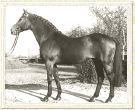
Ladykiller
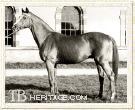
Rantzau
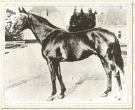
Orange Peel
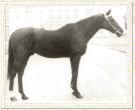
Furioso
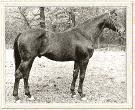
Lucky Boy
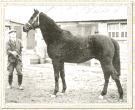
Cottage Son
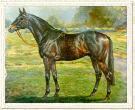
Marlon
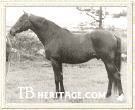
Water Serpent
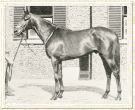
Tamerlane
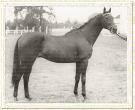
Anblick
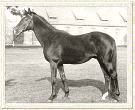
Der Löwe
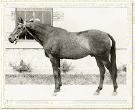
Fra Diavolo
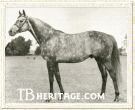
Magic Red
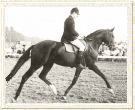
Cardinal
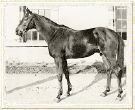
Ultimate
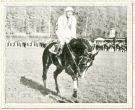
Hurricane
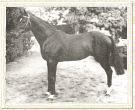
Light o' Love
| | Waterford Crystal, Holstein, Gelding, 1991, by Landgraf I out of Ulme by Corvado, out of Akazie by Duellant, out of Linde by Figaro: Gold Medal. The Ladykiller son Landgraf I is one of the giants of showjumper breeding, and Waterford Crystal also counts Cor de la Bryère and Ramiro (cf. Royal Kaliber) among his near ancestors. Unusually for a Holsteiner, Waterford Crystal's grandam Akazie is a daughter of the Hanoverian jumping progenitor Duellant, due to her female line, the Holsteiner broodmare family No. 162, having branches both in Holstein and in Hanover. Waterford Crystal is a full brother of the Holsteiner stallion L'Ami.
Baloubet du Rouet, Selle Français, Stallion, 1989, by Galoubet A out of Mesange du Rouet by Starter, out of Badine by Bel Avenir, out of Perle de Norval by Rantzau TB: Silver Medal. Having won the World Cup a record three times, an individual championship medal is just the icing on the cake to confirm Baloubet among the all time greats of the sport. As mentioned already, his sire Galoubet A won a team Gold medal at the 1982 World Championship. Galoubet is a son of the great jumping progenitor Almé, out of the French Trotter mare Viti. Baloubet's dam Mesange is inbred 2 x 3 to Rantzau TB, the sire of Cor de la Bryère. Baloubet is linebred to Orange Peel TB and to Vas-Y-Donc, two names that are almost omnipresent in modern Selle Français showjumper pedigrees.
Royal Kaliber, KWPN, Gelding, 1993, by Ramiro out of Fiedonja by Voltaire, out of Adonja by Stuyvesant TB, out of Sonja by Frappant: Bronze Medal and team Silver. Throughout the 1990s, the Holsteiner stallion Ramiro (aka Ramiro Z) was the world's leading showjumping sire, with his daughter Ratina Z winning practically every honour available. The first Olympic medal won by Ramiro's offspring was a team Bronze as long ago as 1984. Royal Kaliber's maternal grandsire Voltaire is a Hanoverian grandson of Furioso TB and of Gotthard, who is arguably the greatest jumping progenitor Hanover has produced. Voltaire's sire Furioso II is well known, particularly as the sire of the evergreen Hanoverian For Pleasure. Fiedonja's dam Adonja is a daughter of the relatively unimportant German thoroughbred Stuyvesant.
Montender, KWPN, Stallion, 1994, by Contender out of Jesprit by Burggraaf, out of Esprit by Le Mexico, out of Vanessa (by Rutbeek?): fourth place and team Gold. Although a Dutch warmblood, Montender's sire and maternal grandsire are Holsteiner stallions, while his grandam Esprit is a daughter of the Selle Français Le Mexico, whose sire Mexico was a full brother of Furioso II (cf. Royal Kaliber). Montender is inbred 3 x 4 to Cor de la Bryère, and 4 x 4 to Ladykiller TB. In addition, Montender is linebred 6 x 7 x 5 toFurioso. Another noteworthy ancestor is Contender's grandsire Ramiro, the sire of the Bronze Medal winner Royal Kaliber.
Mac Kinley, KWPN, Gelding, 1994, by Goodwill out of Irisinaa by Nimmerdor, out of Daisinaa by Purioso, out of Zarina by Lucky Boy TB: joint fifth and team Bronze. Goodwill (nee Lanciano) is a Holsteiner son of Landgraf I, the sire of the Gold Medal winner Waterford Crystal. Irisinaa's sire Nimmerdor is one of the most successful showjumping sires ever bred in the Netherlands. Nimmerdor's Holsteiner sire Farn can also be found in Goodwill's pedigree, so that Mac Kinley is inbred 4 x 3 to this ancestor. Like Royal Kaliber, Mac Kinley also descends from Furioso II. Lastly, Mac Kinley's great-grandam Zarina is by the well known thoroughbred Lucky Boy out of the famous mare Morgenster, who featured prominently in the pedigree of Milton.
Magic Bengtsson, Holstein, Gelding, 1994, by Landos out of Alana by Lagretto, out of Schneeflocke by Marsala, out of Lana by Wildfeuer: joint fifth and team Bronze. Landos descends from Ladykiller TB and from Cor de la Bryère, and he is linebred to Cottage Son TB. Alana also descends from Ladykiller TB, so that Magic Bengtsson is inbred 3 x 4 to this progenitor. Schneeflocke's sire Marsala was a son of Marlon TB, an Irish thoroughbred who has had significant influence on Holsteiner female lines, with the World Champion Lianos among his descendants. Also of particular interest is Lana's sire Wildfeuer, being a grandson of Water Serpent TB, who was one of the most prolific jumping sires in Ireland in 1940s and 1950s.
Parco, BWP, Stallion, 1992, by Darco out of Iliona v/h Carelshof by Attack Z, out of Eleonore by Donnersberg, out of Fara by Frühling: joint fifth. Darco, well-known to those who followed showjumping in the early 1990s, is a son of the Hanoverian Lugano van la Roche out of a granddaughter of Cottage Son TB. Attack Z is a son of Almé. Altogether, Parco's pedigree is a mixture of quality Hanoverian, Westphalian, Holsteiner and Selle Français bloodlines.
Carling King, Irish Sport Horse, Gelding, 1991, by Clover Hill out of Gortnageer Star by Chairlift TB, out of Diamond Knight by King of Diamonds, out of Ballinvullen Nun by Carnival Night TB: joint fifth. Carling King already won a team Gold medal at the 2001 European Championship, and he was among the finalists at the 2002 World Championship. With Clover Hill, Chairlift TB, King of Diamonds and Carnival Night TB among his ancestors, his pedigree reads like a who's who of Irish Sport Horse breeding in the 1990s.
Mr. Springfield, Irish Sport Horse, Gelding, 1993, by Western Promise out of Glebe Bess by Ballinahow Boy, rest unknown: joint fifth. Western Promise is an Irish Sport Horse, descending from Tamerlane TB, who can be found in many good jumping pedigrees. For example, his son Marlon TB made some impact on the Holsteiner studbook, while his grandson Strong Gale was the unchallenged leading National Hunt sire in Ireland and Britain throughout most of the 1990s. Glebe Bess is an Irish Draught mare, but the Irish Draught Mare Book contains no details of her female ancestry.
Clinton, Holstein, Stallion, 1993, by Corrado I out of Urte by Masetto, out of Ohra by Landgraf I, out of Brikscha by Raimond: joint fifth. Corrado I is a son of Cor de la Bryère, and a grandson of Capitol I (cf. Cento). Urte's sire Masetto descends from Maximus, a son of the German thoroughbred Manometer. Maximus is also the maternal grandsire of Capitol I, so that Clinton is linebred to this ancestor. Other duplications in Clinton's pedigree are linebreeding to Cottage Son TB and Ramzes. Lastly, Urte's dam Ohra is a daughter of Landgraf I.
In addition to the above, the remaining medal winners were:
Goldfever, Hanover, Stallion, 1991, by Grosso Z out of Gundula by Galvano, out of Dana by Damhirsch, out of Wunschgabe by Wrede: team Gold. This was the third championship team Gold medal for Goldfever. Having also won the European Championship Silver, two Aachen Grand Prix and the Calgary Grand Prix, he is one of the most successful showjumpers in the World today. Grosso Z descends from Gotthard and Furioso II, and the Holsteiner mare Heureka, the grandam of Ratina Z. Gundula is a granddaughter of the great Hanoverian sire Grande, and she is inbred 4 x 4 to Duellant. Goldfever is linebred to the Hanoverian mainstays Goldfisch II, Der Löwe TB and Abglanz.
Cento, Holstein, Stallion, 1989, by Capitol I out of Viola by Caletto II, out of Lady Legende by Liguster, out of Legende by Löwenjäger: team Gold. Having won the World Cup and the same number of championship team Gold medals as Goldfever, as well as Aachen and Calgary, Cento another one of today's showjumping greats. Although "only" four of the 24 finalists descend from Capitol I, he is in the pedigrees of 10 of the 77 horses who participated in the competition, and he has sired three of them, including two medalists. The Cor de la Bryère son Caletto II is one of the all-time great Holstein sires, with the 1992 Olympic Gold medalist Classic Touch among his many successful offspring. Cento is linebred to Cottage Son and Ramzes.
Cöster, Holstein, Gelding, 1993, by Calato Z out of Dispache by Constant, out of Trinidad by Flamingo, out of Fivitas Dei by Sable Skinflint TB: team Gold. Cöster is the reigning European champion. Calato Z is a son of Capitol I and a grandson of Landgraf I. Constant is a son of Cor de la Bryère. Cöster is linebred to Cor de la Bryère, Cottage Son, Anblick TB and the old-style Holsteiner sire Lopshorn.
Authentic (nee Nimrod), KWPN, Gelding, 1995, by Guidam out of Gerlinda by Katell TB, out of Zinda by Lucky Boy TB, out of Linda by Artilleur: team Silver. With zero faults in the first three rounds and in the subsequent medal jump-off against Sweden, Authentic was the star of the team competition. The Selle Français Guidam (nee Adagio) is a son of the Olympic medalist Quidam de Revel, and thus descends from Ibrahim, Ultimate TB and Fra Diavolo TB. Guidam's dam Fougere descends from Kalabaka TB or Rantzau TB, the convention being that the second covering is assumed to be the effective one. She has further close thoroughbred ancestors on her dam's side, including Magic Red, the maternal grandsire of the triple Grand National winner Red Rum. Fougere is inbred 4 x 4 to Foxhunter TB, and Guidam is linebred 6 x 6 x 6 to Son-in-Law. Authentic's dam Gerlinda is 81.25% thoroughbred, and she is linebred 5 x 5 x 4 to Nearco. Authentic is linebred to Furioso TB. All this may well explain the speed and assuredness with which Authentic mastered the difficult courses in the team competition.
Sapphire (nee Safari v/h Merelsnest), BWP, Mare, 1995, by Darco out of Idjaz-c by Hedjaz, out of Chiquita by Cardinal TB, out of Jugendnixe by Julius Cäsar TB: team Silver. Sapphire is by the same sire as Parco. Idjaz-c is registered in the SBS studbook (Le Cheval de Sport Belge), the smaller of the two Belgian sport horse studbooks. The Selle Français Hedjaz is a son of Ibrahim and a grandson of Ultimate TB. Chiquita is 3/4 thoroughbred and 1/4 Hanoverian.
Fein Cera, Holstein, Mare, 1991, by Landadel out of Cera by Cor de la Bryère, out of Mandalayn by Capitano, out of Gera by Galvini I: team Silver. The star of the 2002 World Championship performed less impressive at the 2004 Olympics, but this does not distract from her being one of the best showjumpers in the world today. Landadel is a son of Landgraf I and inbred 3 x 4 to Ladykiller TB. Cor de la Bryère's daughter Cera won the German showjumping championship under Otto Becker.
Butterfly Flip, SWB, Mare, 1991, by Robin I Z out of Baderna TB by Moderne TB, out of Babette TB by Hurricane TB, out of Bandra TB by Light o' Love TB: team Bronze. Another star of the 2002 World Championship, who has performed impressively throughout the last three years. Robin I Z is a son of Ramiro out of a daughter of Almé, from a Hanoverian female line. Hurricane was an unbeaten racehorse in Sweden and Denmark at ages two and three. Light o' Love was by Pharos, a leading sire of racehorses in England and France.
Cardento, Holstein, Stallion, 1992, by Capitol I out of B-Estelle by Lord, out of Restelle by Sacramento Song TB, out of Estelle by Marconi: team Bronze. On paper, Cardento is inbred 4 x 4 to Cottage Son TB, although it is known in Holsteiner breeding circles that there is a little doubt as to who actually sired Capitol's sire Capitano (the alternative being a grandson, as opposed to a son of Cottage Son TB). Either way, Cardento certainly is linebred to Cottage Son and to Manometer TB. Other notable ancestors include Ladykiller's son Lord, next to Landgraf I the most prominent representative of this line.
|
With every successive international championship, the concentration of specialist jumping bloodlines at the top level of the sport increases. This influence cuts right across the studbooks, as exemplified by a good number of the pedigrees discussed here. The use of sires who have proven their own ability as showjumpers is also on the increase. All this is nothing original, of course, since it only copies a pattern which thoroughbred breeders have followed over the last three centuries.
Back to:
THOROUGHBRED ROOTS OF MODERN SHOW JUMPERS
|
|

